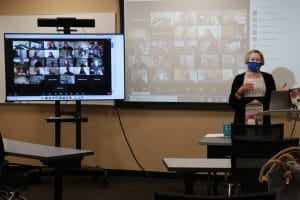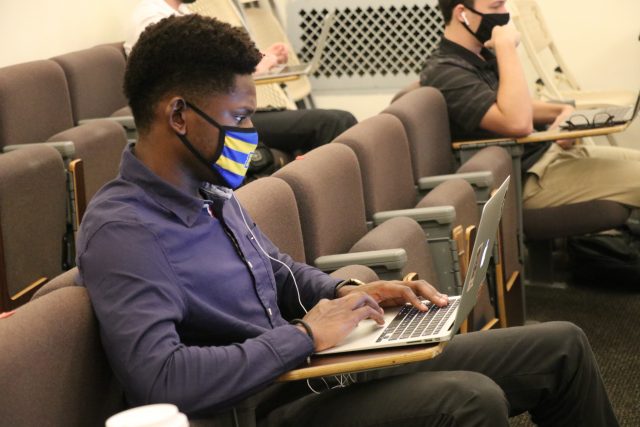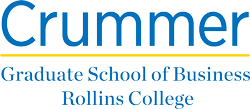FEATURED ARTICLE
Crummer Harnesses the Possibilities of Remote Collaboration with New Technology Enhancements and Innovative Approaches to Learning

As COVID-19 rapidly changes the future of business, Crummer adapts to mirror the workforce of the future with state-of-the-art collaboration tools.
As the spring semester kicks off ten months into the pandemic, the technology advancements made at Crummer in 2020 will have lasting effects long after a vaccine is widely distributed.
When Crummer transitioned into a mixed-delivery of in-person and virtual synchronous learning early this year, Rollins invested in cutting-edge technology in every classroom to develop a seamless environment between those learning in-person and those learning online.
It’s no secret that the COVID-19 pandemic radically altered the way businesses operate, and companies of all sizes now have to be well-versed in mixed-delivery integrating in remote work—a change that will remain long after the virus is mitigated as companies learn that productivity remains strong. In fact, a study by Boston Consulting Group (BCG) found that remote or mixed collaboration maintained productivity just as well as in-person work. Crummer’s new model of immersive collaboration despite physical location is designed to match this workforce of the future.
According to a recent McKinsey & Co. global survey, 85% of respondents say their companies have accelerated digitalization of employee interaction and collaboration. Across the country, almost twice the number of executives stated that they envisioned that at least 10% of their workforce would work up to 2 days remotely each week. And Morgan Stanley and Mondelez have already announced employees will be working in a hybrid model moving forward.
The McKinsey & Co. global survey says it will not be without challenges to manage a partly remote, partly in-person workforce.
“Companies will need to reconstruct how work is done, decide which employees and roles are best suited to remote work, and reconfigure and rethink the workplace,” the survey states. This is the environment Crummer is preparing students to excel within.
Also, a new senior leadership position is popping up at companies under the umbrella of human resources – Director of Remote Work. And while Facebook and GitLab have already hired remote work directors to manage the employee experience for its remote workforce, this is a trend that may carry forward to other industries.
Investment in our Students’ Futures
Recognizing the impact of the pandemic, Rollins and Crummer and took early action to invest in technology that mirrors what students will be experiencing in a post-pandemic workforce.
Each Crummer classroom has been equipped with a Web Cam, designed to capture the faculty and whiteboard in the front of the room, as well as a PolyStudio system, which is the audio hub of the classroom, delivering high-quality audio and a wide-angle view of the of the classroom.
The PolyStudio is connected to a multi-media cart positioned at the front of each classroom, along with a jumbo screen TV monitor that displays a gallery view of the remote students.
 These advancements have already allowed for Crummer professors to enhance the learning experience with the ability to connect beyond the walls of Crummer and into classrooms around the world.
These advancements have already allowed for Crummer professors to enhance the learning experience with the ability to connect beyond the walls of Crummer and into classrooms around the world.
In marketing professor Dr. Ginger Killian’s Professional MBA class, students have had the opportunity to connect via Zoom with two C-Suite leaders – State Farm’s Chief Marketing Officer Rand Harbert and Old Time Pottery’s VP of Marketing Colby Swann.
Utilizing the PolyStudio system, the students were able to meet with the marketing leaders, listen to a guest lecture, and ask questions afterwards.
“The successful transition into the virtual environment has been integral to my education at Crummer. We stayed effectively connected as everything else adapted quickly to the new needs of today’s learning,” said Camil Caro, a Professional MBA student taking Dr. Killian’s marketing course in a virtual synchronous environment. “Exceptional effort has been made to preserve the high standard of content via the mixed virtual and in-class experience. Crummer has shown me that a mixed-model model can be done without sacrificing integrity or one-on-one attention. It has been a phenomenal experience.”
George D. and Harriet Cornell Professor of International Business and Social Entrepreneurship Dr. Mary Conway Dato-on has taken the opportunity to integrate into her classroom students at the EMBA and EAMBA levels from Crummer’s partner business school in Mexico, IPADE.
During the Executive MBA’s Global Immersion Week, 14 students from IPADE joined the EMBA 40 class for a week-long, intensive design thinking challenge. The challenges were sourced from the IPADE students’ work and the cross-cultural teams worked together to offer prototypes that could be considered for deployment.
At the end of the week, the students presented their findings, with some reporting from the Crummer building, some from their virtual place of learning, and some from Mexico.
Introduction to Design Thinking at Crummer, a highly collaborative visually-based course that has been taught by Dr. Conway Dato-on, Dr. Keith Whittingham, and Dr. Keenan Yoho, is using Sprintbase – a virtual design thinking platform – to allow students to actively engage in the design thinking process. Using Sprintbase, the student teams work on a team whiteboard with the instructor moving between breakout rooms of teams to give feedback in real-time.
Forging Ahead
In Crummer’s Career Resource Center, multiple steps are being taken to prepare students for a post-pandemic workforce.

Through the Career Resource Center’s interview coaching, two of the three mock interview coaches did their mock interviews with students in a virtual format – the new norm of many companies these days.
“In our debrief with the coaches, they thought it was very helpful and recommended continuing doing it that way moving forward,” said Renee Quintanilla, the Associate Director of the Career Resource Center. “That was a great way for students to get prepared for virtual interviews because it’s how you dress, what is in your background, the noise level around you, etc.”
Student groups, unable to hold traditional in-person meetings and fundraisers have continued to impact their communities, like the Professional MBA Association, whose members normally host a food and gift drive at Crummer, held a virtual food through the Second Harvest Food Bank of Central Florida. Student organizations like the Crummer Entrepreneurship Association, Crummer Finance Organization, Rollins Moving Services and the Crummer Consulting Group have continued to operate, holding virtual events throughout the semester that have brought in high profile guests like Global Head of IIN at JP Morgan Chase John Hunter, who spoke on the future of blockchain at a Crummer Finance Organization event.
Alumni Relations has also leveraged technological tools in serving both alumni and students. For example the Crummer Connections Webinar Series was launched over the summer and has consistently held thought-provoking virtual events to help alumni stay engaged and informed. Past events have included Post-COVID Latin America featuring Crummer professor Dr. Dan Biller along with multiple professors from Latin America and the Mayor of Teresina, Brazil, as well as Adapting Leadership in a Crisis with Lieutenant General Mark Hertling `19DBA.
“The Crummer Graduate School of Business continues to be steadfast in our commitment to an engaging, concierge approach to education,” said Dr. Dean Deborah Crown. “At Crummer we are leaders and innovators, as we continue forging ahead in our mixed delivery of in-person and the virtual, synchronous learning environment, we are confident that our students and clientele will continue to experience an engaging, collaborative, and highly personalized business education.”

